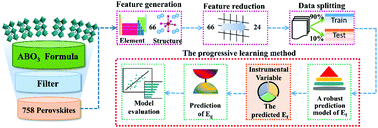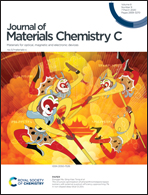A progressive learning method for predicting the band gap of ABO3 perovskites using an instrumental variable†
Abstract
The band structure of perovskite materials can be affected by various factors and it is very sensitive to structural changes; thus, it is always a challenge to make band gap predictions of perovskites. In this work, we proposed a predictive model with a bond-valence vector sum on three sites (A, B and O sites) to characterize the BO6 octahedron distortion. A progressive learning method with an instrumental variable, i.e., formation energy obtained by a robust pre-trained model was used to improve the precision of band gap prediction. After the statistical analysis of the optimal features, the component and structure relationship mapping of the perovskite's band gap are explored. In addition to the element information that represents the component diversity, the bond-valence vector sum considering the relative atomic positions and symmetry and the instrumental variable of formation energy make significant contributions to associate the element information with the band gap. The optimal feature set proposed in this paper solves the problem of description or prediction caused by the structural diversity of perovskites. Of particular significance is that this progressive prediction model proposes an innovative, practical and efficient construction strategy of machine learning to solve complex problems with indirect features.



 Please wait while we load your content...
Please wait while we load your content...